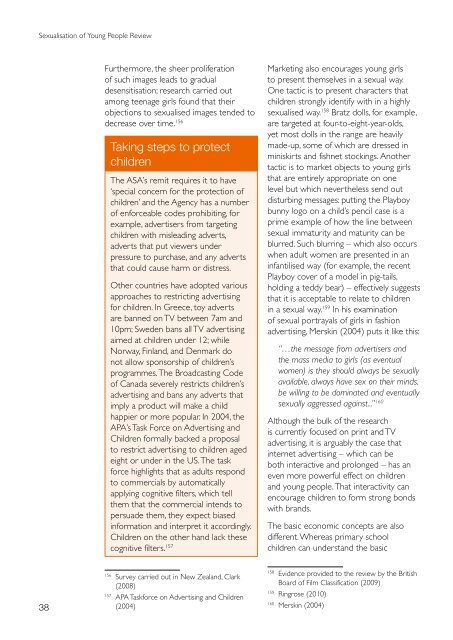Sexualisation of Young People Review
Sexualisation of Young People Review
Sexualisation of Young People Review
You also want an ePaper? Increase the reach of your titles
YUMPU automatically turns print PDFs into web optimized ePapers that Google loves.
<strong>Sexualisation</strong> <strong>of</strong> <strong>Young</strong> <strong>People</strong> <strong>Review</strong><br />
Furthermore, the sheer proliferation<br />
<strong>of</strong> such images leads to gradual<br />
desensitisation; research carried out<br />
among teenage girls found that their<br />
objections to sexualised images tended to<br />
decrease over time. 156157<br />
Taking steps to protect<br />
children<br />
The ASA’s remit requires it to have<br />
‘special concern for the protection <strong>of</strong><br />
children’ and the Agency has a number<br />
<strong>of</strong> enforceable codes prohibiting, for<br />
example, advertisers from targeting<br />
children with misleading adverts,<br />
adverts that put viewers under<br />
pressure to purchase, and any adverts<br />
that could cause harm or distress.<br />
Other countries have adopted various<br />
approaches to restricting advertising<br />
for children. In Greece, toy adverts<br />
are banned on TV between 7am and<br />
10pm; Sweden bans all TV advertising<br />
aimed at children under 12; while<br />
Norway, Finland, and Denmark do<br />
not allow sponsorship <strong>of</strong> children’s<br />
programmes. The Broadcasting Code<br />
<strong>of</strong> Canada severely restricts children’s<br />
advertising and bans any adverts that<br />
imply a product will make a child<br />
happier or more popular. In 2004, the<br />
APA’s Task Force on Advertising and<br />
Children formally backed a proposal<br />
to restrict advertising to children aged<br />
eight or under in the US. The task<br />
force highlights that as adults respond<br />
to commercials by automatically<br />
applying cognitive filters, which tell<br />
them that the commercial intends to<br />
persuade them, they expect biased<br />
information and interpret it accordingly.<br />
Children on the other hand lack these<br />
cognitive filters. 157<br />
Marketing also encourages young girls<br />
to present themselves in a sexual way.<br />
One tactic is to present characters that<br />
children strongly identify with in a highly<br />
sexualised way. 158 Bratz dolls, for example,<br />
are targeted at four-to-eight-year-olds,<br />
yet most dolls in the range are heavily<br />
made-up, some <strong>of</strong> which are dressed in<br />
miniskirts and fishnet stockings. Another<br />
tactic is to market objects to young girls<br />
that are entirely appropriate on one<br />
level but which nevertheless send out<br />
disturbing messages: putting the Playboy<br />
bunny logo on a child’s pencil case is a<br />
prime example <strong>of</strong> how the line between<br />
sexual immaturity and maturity can be<br />
blurred. Such blurring – which also occurs<br />
when adult women are presented in an<br />
infantilised way (for example, the recent<br />
Playboy cover <strong>of</strong> a model in pig-tails,<br />
holding a teddy bear) – effectively suggests<br />
that it is acceptable to relate to children<br />
in a sexual way. 159 In his examination<br />
<strong>of</strong> sexual portrayals <strong>of</strong> girls in fashion<br />
advertising, Merskin (2004) puts it like this:<br />
“…the message from advertisers and<br />
the mass media to girls (as eventual<br />
women) is they should always be sexually<br />
available, always have sex on their minds,<br />
be willing to be dominated and eventually<br />
sexually aggressed against...” 160<br />
Although the bulk <strong>of</strong> the research<br />
is currently focused on print and TV<br />
advertising, it is arguably the case that<br />
internet advertising – which can be<br />
both interactive and prolonged – has an<br />
even more powerful effect on children<br />
and young people. That interactivity can<br />
encourage children to form strong bonds<br />
with brands.<br />
The basic economic concepts are also<br />
different. Whereas primary school<br />
children can understand the basic<br />
38<br />
156<br />
Survey carried out in New Zealand, Clark<br />
(2008)<br />
157<br />
APA Taskforce on Advertising and Children<br />
(2004)<br />
158<br />
Evidence provided to the review by the British<br />
Board <strong>of</strong> Film Classification (2009)<br />
159<br />
Ringrose (2010)<br />
160<br />
Merskin (2004)

















